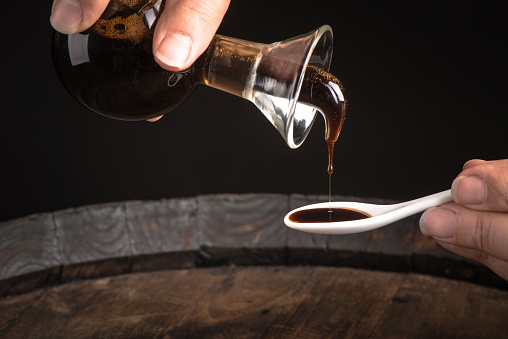Balsamic vinegar is a type of vinegar that is made from grape must, a mixture of pressed grapes, including the skins, seeds, and stems. The must is cooked and then aged in wooden barrels for at least 12 years. The aging process gives balsamic vinegar its unique sweet and tangy taste, as well as its dark brown color.
One of the most common questions people ask about balsamic vinegar is how many calories it contains. The answer is that it depends on the type of balsamic vinegar you are using. Traditional balsamic vinegar, which is aged for at least 12 years, contains around 62 calories per 100 grams. However, there are also “condiment” balsamic vinegars on the market that are made with a shorter aging process and may contain added sugar, which can increase the calorie content.
It’s important to note that balsamic vinegar is a low-calorie condiment, making it a great option for those looking to add flavor to their food without adding many extra calories. One tablespoon of balsamic vinegar contains around 14 calories, which is much less than many other types of dressings and condiments.
Balsamic vinegar is also rich in antioxidants and beneficial compounds. A study has shown that balsamic vinegar contains polyphenols, which are antioxidants that can help protect the body against damage from free radicals. These polyphenols may also help to lower blood sugar levels and improve heart health. Additionally, balsamic vinegar has been shown to have anti-inflammatory properties, which may help to reduce the risk of certain chronic diseases.
Balsamic vinegar is also a good source of antioxidants. These are compounds that can help to protect the body against damage from free radicals, which are molecules that can cause cell damage. The antioxidants in balsamic vinegar include polyphenols and flavonoids, which have been shown to have anti-inflammatory and anti-cancer properties. Some studies have also suggested that balsamic vinegar may help to lower blood sugar levels, which could be beneficial for people with diabetes.
Despite the many benefits of balsamic vinegar, it is important to keep in mind that it is still a high-sodium food. A one-tablespoon serving contains around 70mg of sodium, which can add up quickly if you are consuming multiple servings per day. High sodium intake can increase the risk of high blood pressure, heart disease, and stroke. Therefore, it’s important to limit your consumption of balsamic vinegar if you are trying to reduce your sodium intake.
Another factor to consider is the quality of balsamic vinegar. Not all balsamic vinegars are created equal. Some are made with artificial flavors, colors and sweeteners, which can add calories and lower the nutritional benefits. Furthermore, traditional balsamic vinegar is aged for a minimum of 12 years, and it’s expensive. Some cheaper options may be labeled as “balsamic vinegar” but are made with a combination of wine vinegar and caramel color. These options have less nutritional value and should be avoided.
Another benefit of balsamic vinegar is that it can help to promote feelings of fullness and reduce appetite. This is because the acetic acid in balsamic vinegar can slow down the digestion of carbohydrates, which can help to keep blood sugar levels stable and prevent cravings.
It is also very versatile, it can be used as a dressing for salads, marinade for meat and fish, added to soups and stews, and even drizzled over fruit or ice cream for dessert.
In conclusion, balsamic vinegar is a low-calorie condiment that is also rich in antioxidants and beneficial compounds. It can help to promote feelings of fullness and reduce appetite, as well as adding flavor to food without adding many extra calories. It is a great option for those looking to improve their health and lose weight.

 Home
Home Health
Health Diet & Nutrition
Diet & Nutrition Living Well
Living Well More
More












